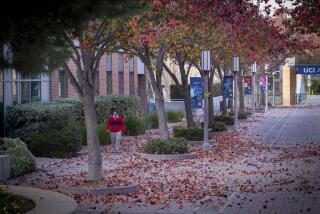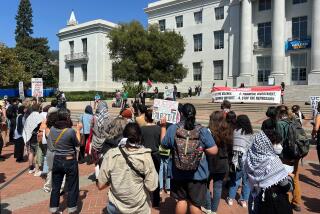With money tight, chancellor says UC Berkeley must ‘reimagine’ its future
A budget deficit at UC Berkeley has hit critical mass and could force a fundamental transformation of the institution, the university’s chancellor announced Wednesday.
In a message to Berkeley students, faculty and staff, Chancellor Nicholas B. Dirks said a “new normal” of dwindling taxpayer support would continue to squeeze one of the nation’s premier public research universities and had prompted a sweeping review likely to bring painful change.
Under a months-long strategic planning process, Berkeley will scrutinize its entire workforce, redesign some academic programs, step up fundraising, expand online course offerings and take other steps to cut costs and increase revenue, Dirks said.
In a teleconference with reporters, Dirks declined to specify areas that might be cut but said officials would carefully choose them rather than impose across-the-board reductions.
See more of our top stories on Facebook >>
He added that faculty and sports teams would be spared and that officials would aim to make up financial shortfalls in the athletic program through more fundraising.
Dirks said the process was aimed at safeguarding Berkeley’s core mission of educational excellence, groundbreaking research and public outreach.
“We are fighting to maintain our excellence against those who might equate ‘public’ with mediocrity, against those who have lost faith in the need for higher education to serve as an engine of social mobility,” Dirks wrote. “What we are engaged in here is a fundamental defense of the concept of the public university, a concept that we must reinvent in order to preserve.”
Berkeley is facing a $150-million budget deficit, amounting to about 6% of its annual operating budget. Without a plan of action, that shortfall is likely to continue, according to campus sources.
The financial squeeze is driven by cutbacks in the amount of money the state provides, UC-mandated tuition freezes, increases in pension and healthcare costs, and growing investments in capital projects, primarily for seismic safety.
Public research universities nationwide are facing similar problems, as states have dramatically cut higher education spending and shifted the financial burden of a college education from taxpayers to students.
The share of a public university degree paid by taxes has dropped to 34% today from 60% in the 1970s, while the share paid by families through tuition has increased to 50% from 33%, according to a new report by the American Academy of Arts and Sciences.
The amount of money the state gave the University of California, as measured per student, fell from $16,000 in 2007-08, before the recession, to $10,000 in 2011-12. Meanwhile, tuition more than doubled between 2002 and 2012, according to a 2014 analysis by the Public Policy Institute of California.
The state has boosted support for UC by more than $760 million since the 2012 passage of Proposition 30, which imposed a temporary tax increase for education and other services.
That support will increase to a cumulative $1 billion by 2016-17 — belying Dirks’ assertion that reduced state dollars for higher education was the “new normal,” according to H.D. Palmer, state finance department spokesman. He did not, however, challenge Berkeley’s budget numbers.
Hans Johnson of the nonpartisan Public Policy Institute of California said he believed the budget woes were real rather than a ploy to receive more state dollars.
At Berkeley, the state’s contribution has dropped from about 50% of the total campus budget in the 1980s to just 13% in 2014-15. Student tuition and fees now account for about 30% of Berkeley’s revenue, which is higher than the average for all nine UC undergraduate campuses.
UC’s freeze on undergraduate tuition rates, set five years ago, is expected to continue until fall, exacerbating Berkeley’s financial woes.
UC President Janet Napolitano said Berkeley was facing more dire financial challenges than the system’s other campuses, in part because of its own “well-intentioned campus choices made over time.”
Among the factors contributing to Berkeley’s problems are an aging infrastructure as the system’s oldest campus, higher faculty salaries driven by the need to compete with other elite universities, a fundraising operation less developed than, say, UCLA, and building projects that ran over budget, UC officials say.
Berkeley officials say they have improved fundraising, bagging more than $3 billion since 2008 from foundations, alumni, businesses and others in their most successful campaign ever. But that was just half of what Stanford raised in a shorter, five-year period.
Napolitano expressed support for the review process and said the lessons learned would be useful to the entire system.
“I have confidence that UC Berkeley will emerge stronger from its comprehensive strategic planning process, ensuring its continued world-class academic excellence and its financial sustainability for the future,” she said in a statement.
To help raise more money, Johnson said increasing tuition or charging higher rates at elite campuses with higher costs might make sense, so long as low- and middle-class students received sufficient financial aid to cover the hikes.
The faculty’s primary concerns are to maintain the 1,500 professors who are tenured or on a tenure track and to make sure that top-quality lecturers are brought in to help accommodate the 750 additional California students that Berkeley has committed to accepting this fall, said Ben Hermalin, the school’s Academic Senate chairman and a professor of economics and business. So far, the faculty has been pleased with the administration’s collaborative approach, he said.
Dirks called on students, staff and alumni to join the process.
“Even now, we plan to do what we have always done at Berkeley: lead the way, and continue to serve as a beacon for the state, the nation and the world,” he wrote.
For more education news, follow me @TeresaWatanabe
ALSO
Union files complaint in USC faculty election
L.A. city, county OK homeless plans, but where will the money come from?
Coastal Commission will hear litany of protests today as it moves to fire its executive director
More to Read
Sign up for Essential California
The most important California stories and recommendations in your inbox every morning.
You may occasionally receive promotional content from the Los Angeles Times.











